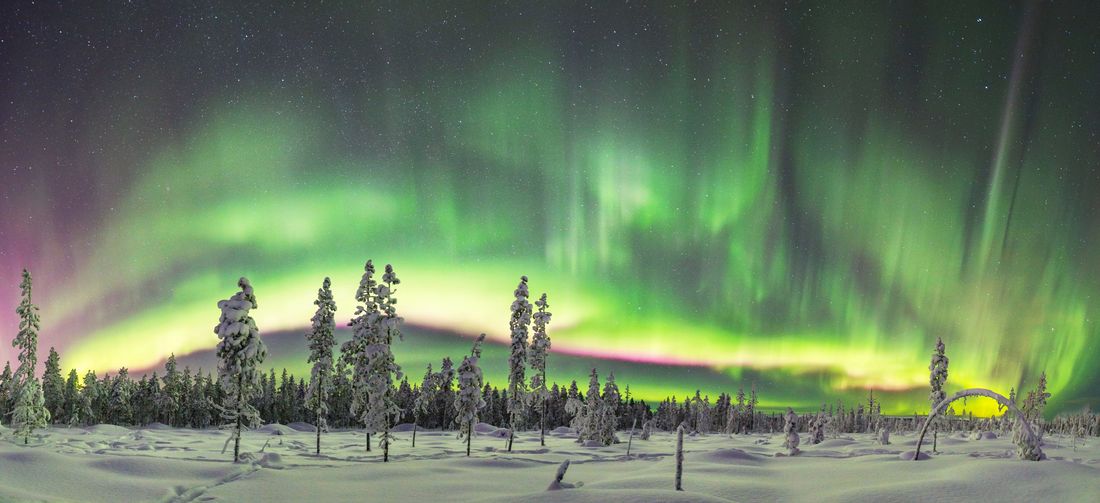Understanding the northern lights
Introduction
Northern and southern lights are extremely complex natural phenoma : they still holds very well their secrets (NASA sent new satellites in March 2015 to better understand them)… However, we know a lot of things. Here are the main key points.
Not being a professional physicist, this article is a compilation of all my readings and exchanges I could have had with professionals.
A little history…
Myths and legends
To explain the formation of northern lights, arctic civilizations have imagined many legends. The Sami people tell that this is the snow raised by the polar fox tail that goes up to the sky to form the auroras. For the Inuit of Greenland, northern lights are the souls of the dead who play with the skull of walruses…
Asian peoples also have their beliefs. 2000 years before Jesus Christ, a Chinese empress had difficulties conceiving a child. Some time after seeing a northern light, she got pregnant. That is why we meet many asian couples in Lapland: making a child under northern lights would offer him a fantastic destiny.
Fridtjof Nansen
The polar explorers were the first to tell civilized countries the beauty of the auroras. One of the most famous, Fridtjof Nansen, tried to reach the North Pole with his boat “Fram” in 1895-96, using the drift of the icecap. Meanwhile, he wrote a book “Farthest North” containing stories and illustrations of northern lights.
A museum was dedicated to him in Oslo, where the Fram is exposed.
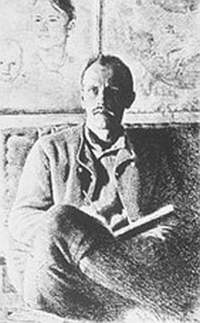
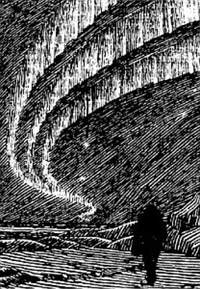
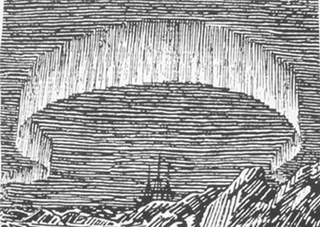
Kristian Birkeland
Kristian Birkeland is a well-known norwegian physicist for being the first in 1895 to reproduce aurora in laboratory during the “Terella” experiments (“small Earth” in latin language). He discovered that the northern lights are the result of an interaction between solar wind particles and the Earth’s magnetic field. Kristian Birkeland’s many contributions to the science led him to be nominated 8 times for the Nobel prize: four times in chemistry and four times in physics.
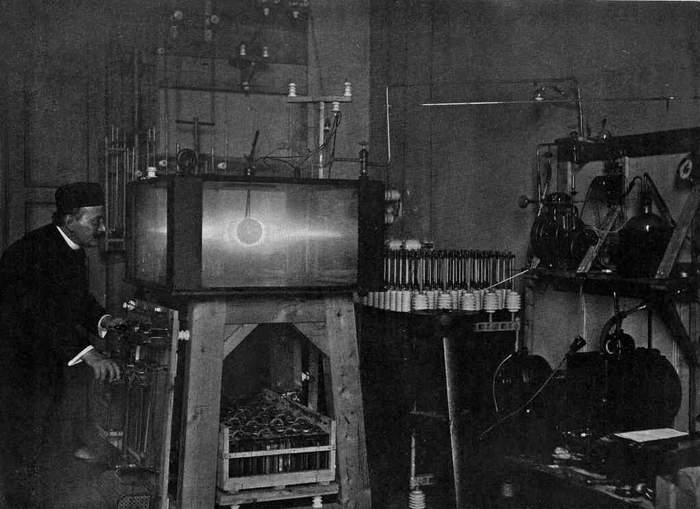
Norway paid him a tribute by creating a 200 crowns banknote (20 €) in his effigy. It is decorated with drawings of his experiences, his discoveries with northern lights.
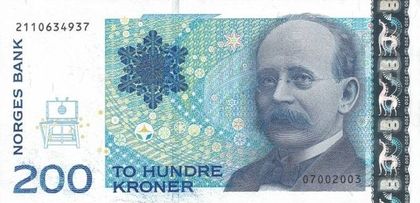
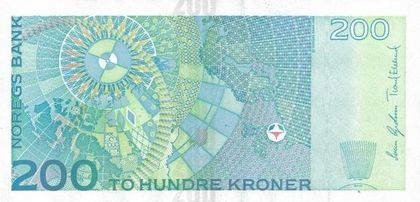
On the Sun…
The solar wind
Northern lights comes from the Sun. It ejects a continuous flow of plasma (an electrically charged gas) in all directions. The consistency of this plasma (density, speed) is directly linked to the solar activity: explosions, coronal holes…
The influence zone of this wind is called the heliosphere and it extends well beyond the Pluto orbit. The end of this zone is called the heliopause. the Voyager I probe, launched in 1977, reached it in 2002 after a 25 years travel in space.
Solar spots
The spots are the seat of powerful magnetic phenomena on the surface of the Sun. These slow down the convection phenomena that produces under the surface of the Sun, which has the effect of cooling the gas zone that is around. As gas is less hot, it is less bright and therefore darker: these are the solar spots.
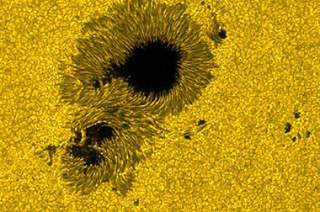
However, solar spots are not at the origin of the northern lights by themselves. These are just colder gases than the other surrounding gases. For a spot to be likely to form a northern light on Earth, it must take an eruption, then maybe a ejection of coronal mass.
Eruptions and coronal mass ejections
Eruptions then coronal mass ejections often have the solar spots for origin. These are often formed by pairs: a spot corresponds to a magnetic north pole, and the other one is the south magnetic pole. It then form powerful magnetic arcs, around which plasma can aggregate during an eruption. When the magnetic field does not ensure the consistency of the arc, it breaks and release all the plasma that he contained in space: it is the coronal mass ejection (CME). If the plasma is released towards the Earth, a northern light can happen a few days later.
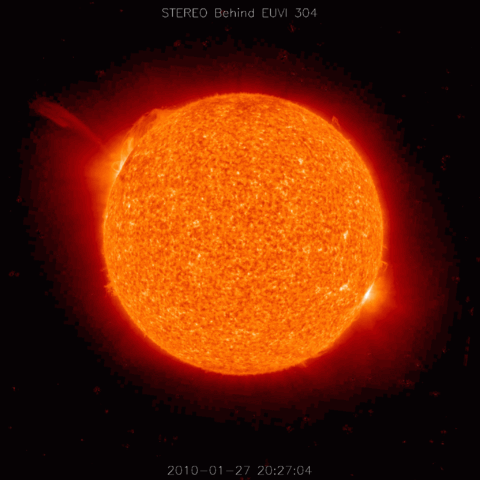
Coronal holes
Coronal holes are areas where the lines of the magnetic field of the Sun are open to space. Solar plasma is not retained and a continuous flow is ejected to space. Coronal holes are real open doors to the interior of the Sun and can also be at the origin of the northern lights if they are facing Earth.
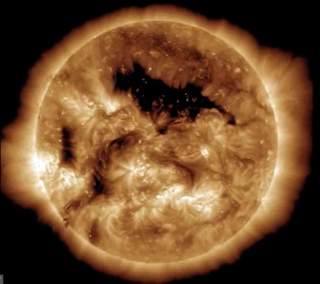
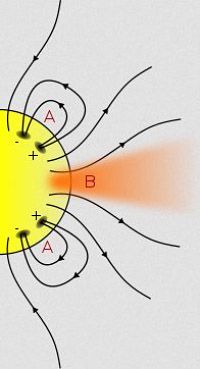
The solar cycle
Since the Sun is observed and studied, it was found that a peak of solar spots is forming every 11 years. But even at the lowest of this solar cycle, it is quite possible to observe beautiful northern lights on Earth. They comes from the coronal holes, which appear very regularly on the surface of the Sun.
On Earth…
The Earth’s atmosphere
The atmosphere is the gaseous envelope which surrounds the Earth. It is composed of 78% diazote (N2) and 21% oxygen (O2). It has different layers (illustration on the right) and it is recognized that the 100 kilometers altitude (the Karman limit) separates the atmosphere of space.
The ionosphere
The ionosphere is the last atmospheric layer. It extends from 50 to 1000 kilometers above the surface, overlapping the mesosphere, the thermosphere and the exosphere (see illustration). The ionosphere is a plasma : atomic oxygen ions and atomic nitrogen bathe in a “soup” of electrons:
- Atomic oxygen and atomic nitrogen come from a dissociation phenomenon of dioxygen and diazote, caused by the UV and X radiation emitted by the Sun.
- This radiation also causes ionization of these atoms (the “soup” of electrons).
The magnetosphere
The magnetosphere corresponds to the region located under a planet magnetic field influence. It is produced by the agitation of the planet metal core. The magnetosphere has no altitude limit: the magnetic field is constantly deformed by the solar wind that undergoes a planet.
The magnetosphere is a true protective shield. For example, the Mars planet, whose metal kernel has become very little active over time, has a very weak magnetosphere. As a result, all its atmosphere has been blown by the solar wind and all its water was evaporated in the cosmos.

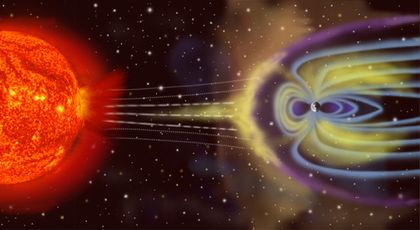
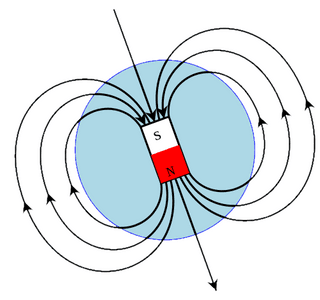
The formation of the northern lights
The light emission phenomenon
Solar plasma particles penetrate in the ionosphere by the poles. They are then guided by the magnetic field lines. By borrowing these field lines, plasma particles will excite on their passage the ionosphere ions, which will then emit light.
The auroral ovals
Plasma particles arrive on Earth by the poles. They move by following complex electrical circuits connecting the magnetosphere with ionosphere. Birkeland was the first to suspect the existence of these circuits, and the model he proposed was since completed.
At the end, these electrical circuits form a circle around the magnetic poles. A bright oval is forming: it’s the auroral oval.
The auroral oval can form both in south and north: we say “northern lights” when the oval forms north (around the north magnetic pole), and “southern lights” when the oval forms south (around the south magnetic pole).
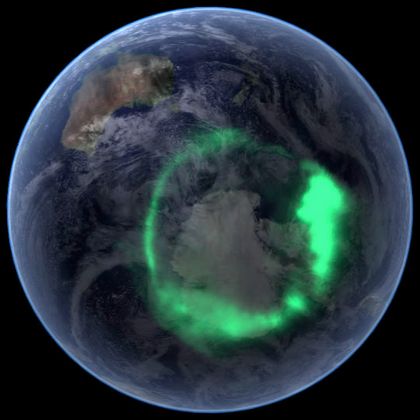
The deformation of the auroral oval on the night side
The brightest northern lights happen on the night side of the Earth(see photo above). Which is rather paradoxical because it’s the day side of the Earth that is most exposed to the Sun. The image below help us to better understand the phenomenon: the structure of the Earth’s magnetosphere.
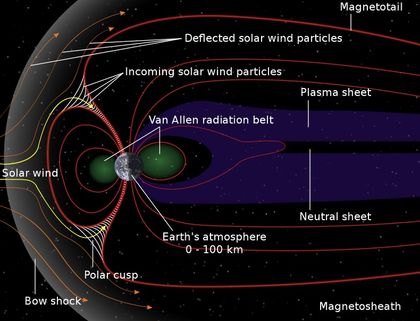
On the arrival of a solar storm on magnetosphere (it’s a “magnetic storm”), two scenarios happen:
- 1. The particles of the storm rush through the cones. This scenario cannot lead to a bright aurora, because the base of the polar cones is very narrow and the magnetic field is very strong. Few of particles will enter the ionosphere by this way.
- 2. The following scenario explains the formation of bright auroras and its description is simplified. Check my references for more details.
The plasma particles are then repelled into the plasmagain (see diagram below) on the night side.
The plasmagain is separated in 2 parts (upper and lower) by a neutral sheet. During a strong solar storm, they will fill. Under the pressure of the upper layers of the magnetosphere (lobes), the 2 plasma sheets will also stretch . These 2 combined effects will have the effect of compressing the neutral sheet. The lower and upper parts will then be join: a violent magnetic phenomenon occurs, the “reconnection”.
This reconnection will catapult plasma particles towards the ionosphere: it is the “sub magnetic storm”. The particles are accelerated and will penetrate in number in the ionosphere, which will produce bright auroras. This phenomenon is, however, still poorly understood by scientists.
Finally, note that there may be a magnetic storm even when no magnetic storm has arrived on Earth. The magnetic storm just creates favorable conditions for a sub magnetic storm to occur. So we can observe auroras even when there is no solar storm. However, they will be less bright and shorter.
The position of the ovals
Auroral ovals form around magnetic poles and have a width varying from 500 to 1000 kilometers approximately. However, their diameter will vary depending on the point where the magnetic reconnection happen on the night side (see above). The more it gets far, the more the lines of magnetic fields are pulled, which has effect to pull further south (or north for the southern auroras) the auroral ovals.
Therefore:
- During a strong sub magnetic storm, an observer who is too north will see the aurora on the southern horizon.
- When the sub magnetic storm is not strong enough, an observer located too far south will see the aurora on the northern horizon.
In summary…
The following video is interesting because it shows the sequence phenomena that is at the origin of the northern lights on Earth. It is shown in the Polaria Museum of Tromsø, Norway.
The colors of the northern lights
The Bohr-Rutherford model
The northern lights result from the luminescence of the upper atmosphere due to the de-excitation of molecules in the atmosphere. For a better understanding of this phenomenon, we must first understand the structure of the atom.
An atom is made up of particles: protons and neutrons form its nucleus, while electrons revolve around it. Attention, the model described here is now outdated by the principles of quantum mechanics, and is only used for educational.
Rutherford was the first to assign a planetary structure to the atom : the electrons are separated by void and revolve around the nucleus, like the planets around the Solar system.
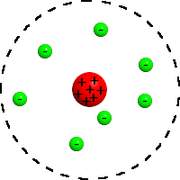
Niels Bohr completed Rutherford’s model by bringing the following constraints:
- An electron can be found only in a precise orbit around the atom: the electronic layers.
- Electrons cannot change layer (unless they are excited, see below).
- Each of these layers can receive a precise number of electrons.
- A layer can only accommodate electrons if the previous one has been fulfilled. There are 7 different electronic layers: the K layer is closest to the nucleus (level 1, the “fundamental” orbit), and the Q layer is the most distant (level 7). Each has an energy level denoted “n”. The lowest energy is the one of the layer that is closest to the nucleus (layer K, n = 1), the strongest one is the one that is the farthest from the nucleus (Q layer, n = 7).
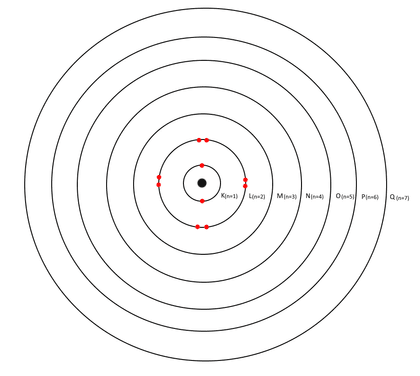
The Luminescence
We have just seen that according to Bohr, the electrons can be located only on a well defined layer around the nucleus of the atom and that they could not change it.
Unless they are excited: shock with another particle (photon, free electron, etc.), impact with an atom… If supplied energy is sufficient and not too strong, Bohr specifies that the electron can change its orbit, and then return to its original position. But to return to its original position (a lower energy level layer), the electron must release its excess of energy in the form of a photon.
The return to the original orbit of the electron can be accomplished in one or many stages:
- Gradually return to the original orbit.
- Return to original orbit in one jump.
- Or return to the original orbit by skipping a few orbits.
The wavelength of the emitted photon will depend of the return jump made and of the excited atom. If the wavelength of the emitted photon is part of the visible domain (the light), then we will see a color.
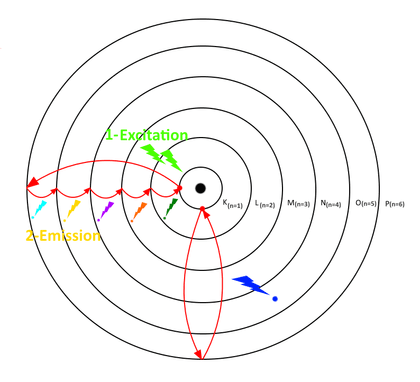
Collisional deactivation
An excited atom (therefore having received a surplus of energy) has seen one or many of its electrons change orbit. These electrons are themselves in unstable states. But they can re-stabilize :
- They can descend from an orbit: a photon is emitted (this is the luminescence).
- Or come into contact with another element (atom / molecule / ion…): in this case, the excess energy is transmitted to element encountered, and no photon is emitted: this is collisional deactivation.
Finally…
We now have all the elements to understand the color of the aurora. They are often green in their lower parts and red in their upper parts. This is explained by the variation of atmospheric density and atmospheric composition, which is depending on the altitude.
Red and blue
In the upper layers of the ionosphere, the atmospheric density becomes very weak. So the oxygen electrons have the time to go down to 2 orbits (2 minutes will be necessary) to stabilize completely (return to their fundamental orbits): they emit a red photon. Blue-violet may also appear on the peak of the aurora: in this case, it comes from the excitement of hydrogen, ionized nitrogen and ionized helium. These gases are lighter than oxygen and are only found in the highest layers of the atmosphere: it requires a strong solar storm for them to be excited.
Green
In the middle layers of the ionosphere, atomic oxygen is predominant (dioxygen is heavier and is found much lower in the atmosphere). The electrons of the excited atom have time to descend from their orbit only once before being deactivated by another atom: they emit green.
Other colors
The composition of the low to medium altitude layers of the ionosphere is very varied: atomic oxygen, atomic nitrogen, ionized nitrogen… Atomic nitrogen emits red, oxygen emits green, and ionized nitrogen emits blue. If the solar wind particles have sufficient energy to reach these lower layers before being stopped, a large palette of colors can be observed: pink, yellow, white…
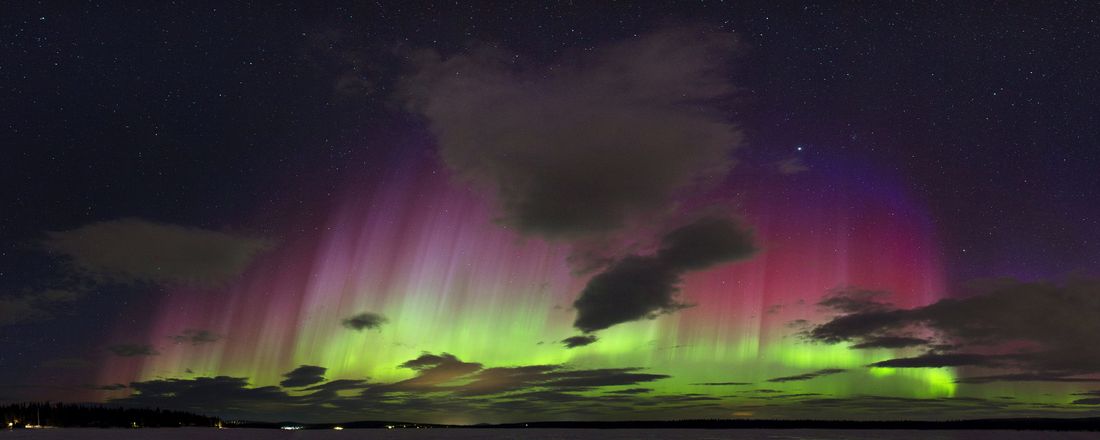
Sources and references
- Wikipedia (french and UK)
- Asashiwa classroom
- Introduction to space physics, by the Paris Observatory (in french)
- Aurora and particle escape above the caps terrestrial polar, by Alexandra Teste (in french)
- Astronomia (in french)
- Luxorion (in french)
- Phy6 (in french)
